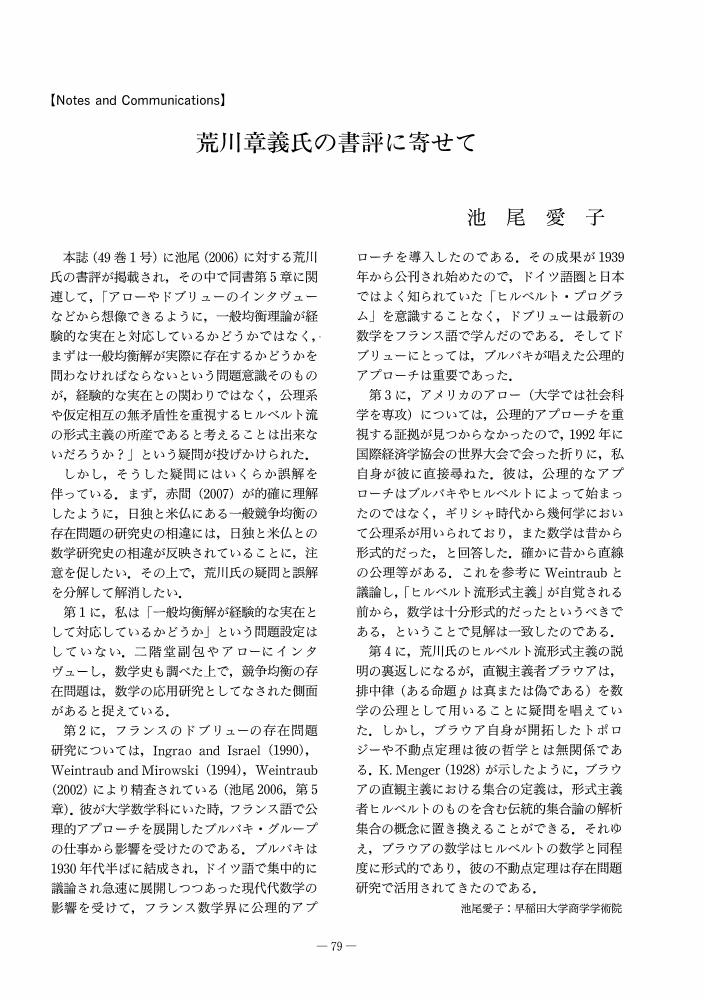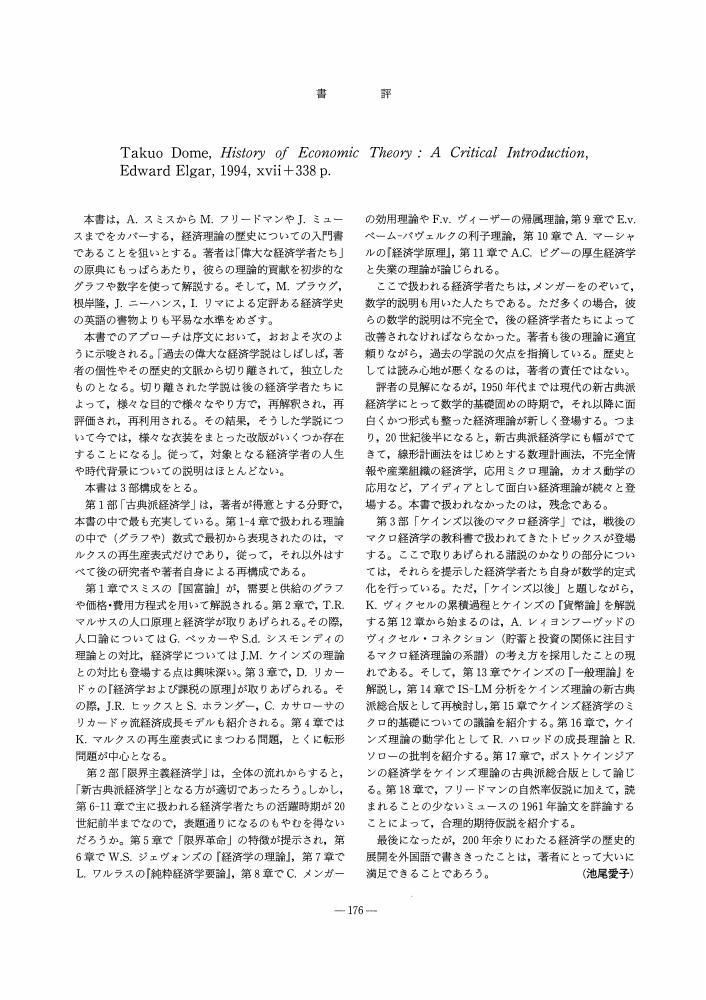9 0 0 0 OA ケインズの経済学からケインズ経済学へ-日本の場合-
- 著者
- 池尾 愛子
- 出版者
- 早稲田商学同攻会
- 雑誌
- 早稲田商学=The Waseda commercial review (ISSN:03873404)
- 巻号頁・発行日
- vol.402号, pp.1-37, 2004-09
2 0 0 0 IR 天野為之と唐津
- 著者
- 池尾 愛子
- 出版者
- 早稲田商学同攻会
- 雑誌
- 早稲田商学 (ISSN:03873404)
- 巻号頁・発行日
- no.461, pp.1-27, 2021-09
2 0 0 0 OA 経済学の歴史と展望論文 根岸 (2004) に寄せて
- 著者
- 池尾 愛子
- 出版者
- 経済学史学会
- 雑誌
- 経済学史学会年報 (ISSN:04534786)
- 巻号頁・発行日
- vol.46, no.46, pp.97-99, 2004 (Released:2010-08-05)
- 参考文献数
- 23
2 0 0 0 OA K. ヴィクセルの経済学とその歴史的背景
- 著者
- 池尾 愛子
- 出版者
- The Japanese Society for the History of Economic Thought
- 雑誌
- 経済学史学会年報 (ISSN:04534786)
- 巻号頁・発行日
- vol.29, no.29, pp.1-11, 1991 (Released:2010-08-05)
- 参考文献数
- 49
1 0 0 0 OA 1997年東アジア通貨危機と2008年アメリカ金融危機の再考
- 著者
- 池尾 愛子
- 出版者
- 早稲田商学同攻会
- 雑誌
- 早稲田商學 (ISSN:03873404)
- 巻号頁・発行日
- vol.429, pp.153-176, 2011-09-15
1 0 0 0 OA 田中王堂のプラグマティズムと経済思想
- 著者
- 池尾 愛子
- 出版者
- 早稲田大学アジア太平洋研究センター
- 雑誌
- アジア太平洋討究 (ISSN:1347149X)
- 巻号頁・発行日
- vol.35, pp.129-145, 2019-01-31 (Released:2022-09-16)
- 参考文献数
- 69
After studying at Tokyo Senmon Gakkō, Ōdō Tanaka (1867–1932) stayed in the US for more than eight years from 1889, and taught philosophy at Waseda University for more than 30 years. At the University of Chicago, Tanaka was supervised by John Dewey (1859–1952) and trained also by William James (1842–1910, the author of Pragmatism) and George Santayana (1863–1952). Tanaka naturally became a pragmatist. Tanaka, like James and Dewey, praised utilitarianism highly, and therefore he paid attention to the development of utilitarianism, political economy, and economics.In the early twentieth century, several scholars became interested in Sontoku Ninomiya (1787–1856, economic reformer and thinker). Tameyuki Amano (1861–1938, economist at Waseda University) introduced the teachings of Ninomiya into his Discourse on Thrift and Savings (1901) and his edited textbook New Commercial Reader (1911, 1913). In contrast, Tanaka regarded Ninomiya as a philosopher and authored A New Study of Sontoku Ninomiya (1912) by bringing focus into pragmatist, utilitarian, and individualist arguments in Ninomiya’s writings. Tanaka carefully examined Ninomiya’s concept of “chūyō (golden mean, constant mean),” which could serve as the criterion when a spectator questioned if something contributed to the happiness of a person or mankind in the world. Later Tanaka came to realize that Ninomiya’s concept of “suijō (concession)” should have something to do with Adam Smith’s concept of “parsimony.”It is noteworthy that Dewey visited Japan in March and April 1919 and his lectures given at the University of Tokyo became the book Reconstruction in Philosophy in 1920. It is also important to remember that Dewey accepted the warm invitation sent by Hu Shih (1891–1962), his former student at Columbia University and a philosopher at Peking University, to visit China and then he spent more than two years on giving lecturers at Peking, etc.With reference of Tanaka’s pragmatism, Dewey’s 1920 book, and Amano’s economics, this paper relates Adam Smith’s Theory of Moral Sentiments (1759) and The Wealth of Nations (1776) with the use of the idea of “contributing to the happiness of mankind.” It also argues that Western economic thought has developed from some part of Western philosophy and that Western philosophy and economic thought have deeply connected with Christianity.
1 0 0 0 OA 国際経済摩擦と日本の経済学者たち : 1985年の転換点
- 著者
- 池尾 愛子
- 出版者
- 早稲田大学産業経営研究所
- 雑誌
- 産業経営 (ISSN:02864428)
- 巻号頁・発行日
- vol.35, pp.75-95, 2004-06-15
1 0 0 0 OA 荒川章義氏の書評に寄せて
- 著者
- 池尾 愛子
- 出版者
- 経済学史学会
- 雑誌
- 経済学史研究 (ISSN:18803164)
- 巻号頁・発行日
- vol.49, no.2, pp.79-80, 2007-12-25 (Released:2010-08-05)
- 参考文献数
- 6
- 著者
- 池尾 愛子
- 出版者
- The Japanese Society for the History of Economic Thought
- 雑誌
- 経済学史学会年報 (ISSN:04534786)
- 巻号頁・発行日
- vol.39, no.39, pp.199-200, 2001 (Released:2010-08-05)
1 0 0 0 OA History of Japanese Economic Thought
- 著者
- 池尾 愛子
- 出版者
- The Japanese Society for the History of Economic Thought
- 雑誌
- 経済学史学会年報 (ISSN:04534786)
- 巻号頁・発行日
- vol.39, no.39, pp.94-102, 2001 (Released:2010-08-05)
- 参考文献数
- 29
There are several groups of scholars, both non-Japanese and Japanese, pursuing historical studies of Japanese economic thought. There have been significant societal activities such as nationwide meetings organized by the Society for the History of Japanese Economic Thought and publications both in English and in Japanese on the history of Japanese economic thought by the Japanese Society for the History of Economic Thought. Frequently discussed topics are the economic ideas in the closeddoor period, Japanese enlightenment and modernization, the introduction of Western economics into Japan, Japanese contributions to economics, and the internationalization of economics. Japan has a rich history of economic thought cultivated in Japan from the Tokugawa period to the present. Unfortunately the research results are scattered in various academic journals, commercial magazines, and university organs. Therefore, books and monographs are a powerful medium in this field. The creation of a single forum, ideally electronic, for scholarly communication is most urgently needed in order to inform the general population, including economists, of the serious research results regarding this subject. One of the important goals that Japanese scholars should attempt is to produce research results in English even if they lose something in translation.
- 著者
- 太田 仁樹 池尾 愛子
- 出版者
- The Japanese Society for the History of Economic Thought
- 雑誌
- 経済学史学会年報 (ISSN:04534786)
- 巻号頁・発行日
- vol.35, no.35, pp.173-175, 1997 (Released:2010-08-05)
1 0 0 0 OA Takuo Dome, History of Economic Theory: A Critical Introduction, Edward Elgar, 1994, xvii+338p.
- 著者
- 池尾 愛子
- 出版者
- The Japanese Society for the History of Economic Thought
- 雑誌
- 経済学史学会年報 (ISSN:04534786)
- 巻号頁・発行日
- vol.33, no.33, pp.176, 1995 (Released:2010-08-05)
1 0 0 0 OA 米市場についての統計学的研究
- 著者
- 池尾 愛子
- 出版者
- The Japanese Society for the History of Economic Thought
- 雑誌
- 経済学史学会年報 (ISSN:04534786)
- 巻号頁・発行日
- vol.31, no.31, pp.80-89, 1993 (Released:2010-08-05)
- 参考文献数
- 71
In the 1930s, many Japanese economists were absorbed by the study of the socalled rice problem, i. e. the instability of the price of rice and its supply. Two organizations were important for the advancement of the study. The Agricultural Economic Society was established for the study on all problems related to rural districts and agriculture in 1924. The Japan Society for the Promotion of Science, which was established in 1932, asked leading applied economists to form a committee for the theoretical and practical study on rice policy in 1933. Y. Yagi constructed the price and quantity indices of rice during one year following Parsons's method. E. Sugimoto was requested by Japan Society for the Promotion of Science to make a statistical study of the law of demand for rice.These early econometric works on rice have been forgotten not only by many economists but also by historians of economic thought. In the 1940s, there was a paradigmatic shift in econometrics. Keynesian macroeconomics and W. Leontief's input-output analysis began to gain popularity in place of the Marshallian single market approach. Also, econometricians became more absorbed in the analysis of the industrial rather than the agricultural sector.
- 著者
- 池尾 愛子
- 出版者
- The Japanese Society for the History of Economic Thought
- 雑誌
- 経済学史学会年報 (ISSN:04534786)
- 巻号頁・発行日
- vol.29, no.29, pp.40, 1991 (Released:2010-08-05)
1 0 0 0 OA 田中王堂のプラグマティズムと経済思想
- 著者
- 池尾 愛子
- 出版者
- 早稲田大学アジア太平洋研究センター
- 雑誌
- アジア太平洋討究 (ISSN:1347149X)
- 巻号頁・発行日
- vol.35, pp.129-145, 2019-01-31






